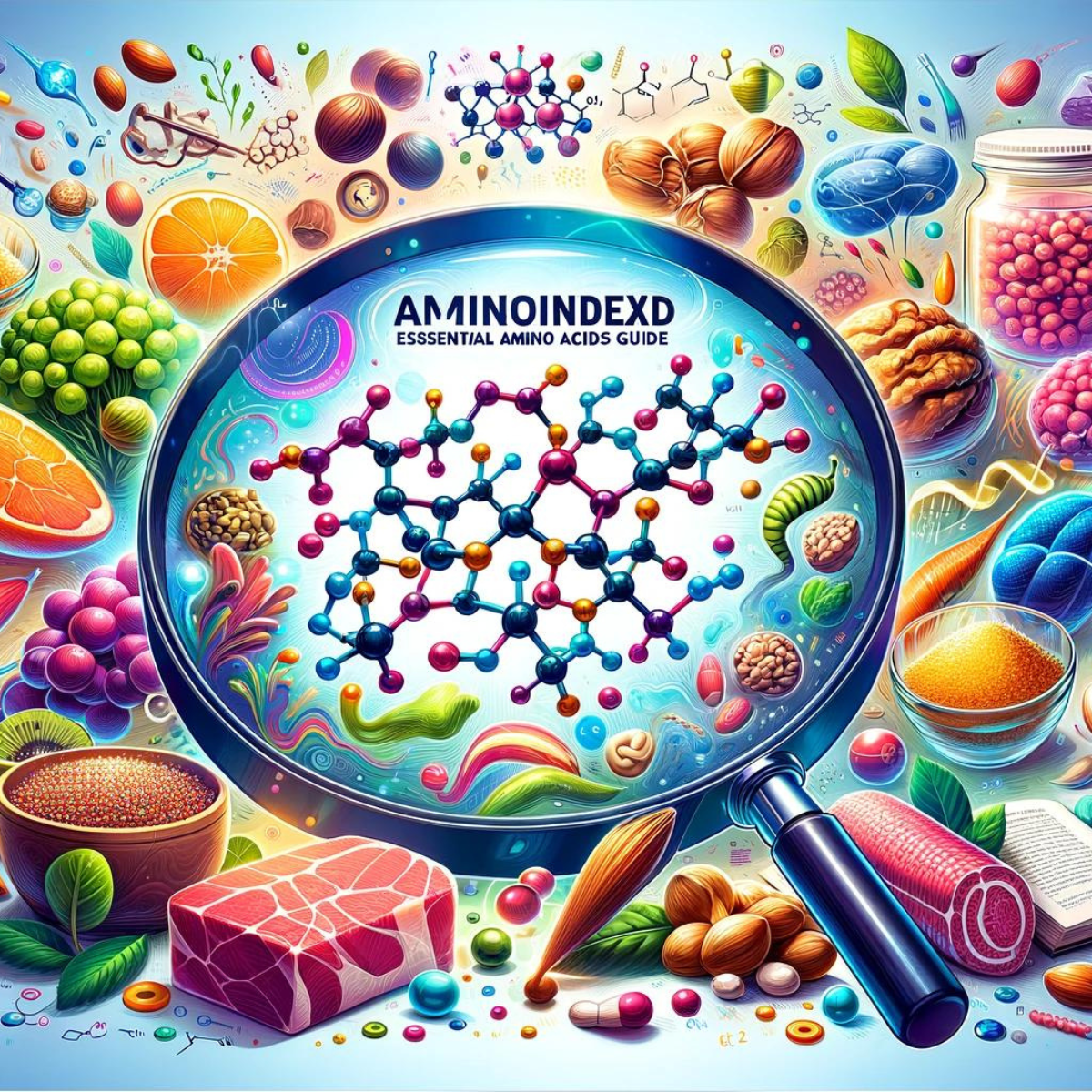Table of Contents
- Introduction
- Understanding DIM: A Comprehensive Introduction
- Optimizing Health with DIM: Top Lifestyle Practices
- Cruciferous Powerhouses: Key Foods for DIM Intake
- DIM vs. Hormone Replacement: Understanding the Difference
- DIM's Role in Cancer Prevention: Separating Fact from Fiction
- Exploring DIM's Impact on Weight Management
- The Universal Benefits of DIM: Not Just for Women
- Safety First: The Dos and Don'ts of DIM Supplementation
- Frequently Asked Questions About DIM
- Key Takeaways
- Conclusion
- Disclaimer
- Shop DIM
Introduction
Diindolylmethane (DIM), a unique natural compound found in cruciferous vegetables like broccoli, cauliflower, and Brussels sprouts, is making waves for its distinctive role in hormone balance and overall health. In this all-encompassing guide, '"DIM Uncovered: Myths, Facts, and Health Gains,'" we delve into the intriguing science behind DIM, spotlighting its myriad health benefits and debunking prevalent misconceptions about its use.
From its anti-inflammatory properties to its potential role in cancer prevention, DIM offers many health benefits increasingly gaining recognition. This guide is a valuable resource for understanding and harnessing the potential of this remarkable compound, whether you're seeking its hormonal benefits, exploring its cancer-preventive properties, or simply looking to enhance your overall health.
Understanding DIM: A Comprehensive Introduction
Diindolylmethane (DIM) may not be a household name. Yet, its impact on health is both significant and scientifically recognized, particularly among those seeking to manage their hormone levels and reduce cancer risk naturally. DIM originates from a compound found in cruciferous vegetables such as broccoli, cabbage, and Brussels sprouts. When these vegetables are consumed, the naturally occurring compound indole-3-carbinol (I3C) is transformed by the stomach's acidic environment, producing DIM.
DIM is particularly compelling due to its influence on estrogen metabolism. The body processes estrogen through various pathways that can lead to beneficial or harmful effects, depending on the path taken. DIM promotes a pathway that results in less potent forms of estrogen, which are associated with reduced risks for certain cancers and other health issues related to hormone imbalance.
Beyond its role in estrogen modulation, DIM has been the subject of research for its potential anti-inflammatory, antiviral, and anticancer properties. At a molecular level, DIM stabilizes hormone levels and can influence cell-cycle regulation and apoptosis—critical processes in preventing abnormal cell growth and proliferation.
This compound supports hormonal balance and contributes to a healthier cellular environment, making it a topic of interest for researchers and health enthusiasts. As we delve deeper into the world of DIM, we will explore how integrating it through diet or supplements can play a pivotal role in maintaining health and preventing disease.
Optimizing Health with DIM: Top Lifestyle Practices
Integrating Diindolylmethane (DIM) into your daily routine goes beyond merely taking a supplement; it involves cultivating a lifestyle that complements its benefits. Here are some top lifestyle practices that can enhance the effectiveness of DIM and promote overall well-being:
-
Incorporate Cruciferous Vegetables Regularly
Make cruciferous vegetables a regular part of your diet. Broccoli, Brussels sprouts, cabbage, and cauliflower are rich in DIM and provide fiber, vitamins, and other cancer-fighting compounds. Aim for at least 3-5 servings per week and include a variety of vegetables to maximize nutrient intake.
-
Maintain a Balanced Diet
To support DIM's benefits, maintain a balanced diet rich in fruits, vegetables, lean proteins, and healthy fats. A well-rounded diet enhances liver function, crucial for hormone metabolism and detoxification.
-
Stay Hydrated
Water is essential for all bodily functions, including detoxification. Staying hydrated helps the body efficiently use DIM and other nutrients, eliminating toxins and supporting cellular health.
-
Regular Physical Activity
Exercise can help balance hormones naturally and is particularly effective when combined with DIM. Regular activity boosts metabolism, reduces stress, and helps maintain a healthy weight, all contributing to optimal hormone levels.
-
Limit Alcohol and Avoid Smoking
Alcohol consumption and smoking can have adverse effects on hormone balance and overall health. Reducing or eliminating these can enhance the effectiveness of DIM in maintaining hormonal balance and reducing cancer risk.
-
Manage Stress Effectively
Chronic stress can disrupt hormonal balance. Practices such as meditation, yoga, and mindfulness can help manage stress, thereby supporting the hormone-regulating effects of DIM.
-
Consider Professional Guidance for DIM Supplementation
Because DIM affects hormone levels, it's wise to consult with a healthcare provider before starting supplements, especially if you have a hormonal disorder or are taking medication. They can guide you through the appropriate dosages and forms of DIM that best suit your health needs.
-
Regular Health Check-ups
Tracking your hormonal health through regular check-ups can help you understand how effectively DIM or any other intervention works. This is particularly important for those using DIM for specific health issues like estrogen dominance or prostate health.
-
Sleep Well
Adequate sleep is crucial for hormone production and balance. Ensure you get 7-9 hours of sleep per night to help the body regenerate and maintain hormonal equilibrium.
-
Avoid Exposure to Environmental Estrogens
Reduce exposure to xenoestrogens in plastics, pesticides, and certain personal care products. These chemicals can mimic estrogen in the body and disrupt natural hormone levels, potentially diminishing the positive effects of DIM.
By integrating these lifestyle practices, you can enhance the benefits of DIM, supporting your journey towards better hormonal balance and overall health.
Cruciferous Powerhouses: Key Foods for DIM Intake
Incorporating Diindolylmethane (DIM) into your diet starts with understanding which foods are the richest sources. Cruciferous vegetables are the nutritional powerhouses that can boost your DIM intake. Here's a closer look at these essential foods and some tips on how to optimize their DIM content:
Broccoli
Broccoli is a rich source of DIM and contains various vitamins and minerals. To maximize the DIM content, slightly steamed or raw broccoli is best, as overcooking can destroy some beneficial compounds.
Brussels Sprouts
These small but mighty vegetables pack a solid punch of DIM. Brussels sprouts are best roasted or steamed to enhance their flavour while preserving their nutritional value.
Cauliflower
Like its cruciferous cousins, cauliflower provides a good amount of DIM when consumed regularly. It's versatile in the kitchen, perfect for roasting, mashing, or even ricing, making it easy to incorporate into meals.
Cabbage
Cabbage is another excellent source of DIM. It can be enjoyed raw in salads, fermented as sauerkraut, or lightly cooked. Each method offers different textures and flavours while maintaining its health benefits.
Kale
Kale is a nutrient-dense vegetable that includes DIM among its many benefits. It can be used in salads, smoothies, or chips. Lightly cooking kale can reduce its bitterness and make it easier to digest.
Tips for Maximizing DIM Intake from Foods
- Variety and Rotation: Rotate these vegetables to avoid boredom and enhance nutrient intake. Each offers unique benefits and flavours.
- Cooking Methods: Light cooking methods such as steaming or sautéing are preferable. They help break down vegetable fibres, making DIM more available without destroying their properties.
- Organic Choices: Whenever possible, choose organic cruciferous vegetables to avoid pesticide residues affecting hormonal balance.
- Daily Intake: Aim to include at least one serving of cruciferous vegetables in your diet daily. This consistent intake helps maintain steady levels of DIM in your body.
Incorporating these cruciferous vegetables into your diet effectively enhances your DIM intake, supporting your body's hormonal balance and overall health. In the next section, we could delve into how DIM compares to hormone replacement therapies or explore another area you're interested in!
DIM vs. Hormone Replacement: Understanding the Difference
Both Diindolylmethane (DIM) and hormone replacement therapy (HRT) are used to manage hormonal issues, but they work in different ways and serve various purposes in healthcare. Understanding these differences can help individuals make informed decisions about their health management strategies.
What is DIM?
DIM is a natural compound derived from cruciferous vegetables like broccoli and cauliflower. It helps in estrogen metabolism, promoting the conversion of more potent forms of estrogen into less active forms. This action helps maintain a healthy hormonal balance and reduces the risk of certain hormone-related cancers and conditions.
What is Hormone Replacement Therapy?
HRT involves the medical administration of hormones, particularly estrogen and progesterone, to alleviate symptoms associated with hormonal imbalances or deficiencies, such as those occurring during menopause. HRT involves synthetic or natural hormones used to directly replace or supplement the hormones the body is no longer producing in sufficient quantities.
Key Differences
Mechanism of Action
- DIM: Modulates natural hormone metabolism by influencing the body's hormone production pathways.
- HRT: Directly adds hormones to the body's system to mimic or replace the hormones usually produced by the organs.
Usage Goals
- DIM: Often used for long-term health promotion, particularly for its potential cancer-preventive properties and ability to support overall hormonal balance.
- HRT: Typically prescribed for specific therapeutic goals such as relieving menopausal symptoms, preventing bone loss, or treating hormonal disorders.
Side Effects and Risks
- DIM: Being a natural compound, DIM generally has fewer and less severe side effects than HRT. While DIM can cause mild gastrointestinal upset or changes in estrogen levels when taken in high doses, HRT is associated with more significant risks, including an increased risk of blood clots, stroke, and, in some cases, cancer.
- HRT: Associated with more significant risks, including an increased risk of blood clots, stroke, and, in some cases, cancer.
Long-Term Use
- DIM: This can be used as part of a daily diet or as a long-term supplement with relatively low risks.
- HRT: Usually requires careful medical supervision, mainly when used over a more extended period, due to its potential side effects and dangers.
Making the Right Choice
Choosing between DIM supplementation and HRT should be based on individual health needs and existing conditions and under the guidance of a healthcare provider. For those looking for a natural approach to support hormonal balance and reduce cancer risk, DIM may be a suitable option. However, for those dealing with severe symptoms of hormone depletion or specific medical conditions, HRT might be necessary and more effective.
In summary, DIM offers a natural way to modulate hormone levels and support overall health with fewer risks, making it a favourable option for many looking to maintain hormonal balance naturally. HRT, while adequate for specific therapeutic needs, comes with higher risks and requires careful medical oversight.
DIM's Role in Cancer Prevention: Separating Fact from Fiction
Diindolylmethane (DIM) has garnered significant attention for its potential cancer-preventive properties, mainly due to its influence on hormone metabolism. However, it's important to carefully navigate between the scientifically supported benefits and the myths that often circulate in health discussions. Here's what current research says about DIM's role in cancer prevention:
Scientifically Supported Benefits
Estrogen Metabolism: DIM helps promote the conversion of estrogen to its less potent forms, which is believed to reduce the risk of developing hormone-sensitive cancers such as breast and prostate cancer.
Anti-Inflammatory Actions: Chronic inflammation is a known risk factor for many types of cancer. DIM has demonstrated anti-inflammatory properties that could lower the risk of cancer development.
Inhibition of Cancer Cell Growth: Studies have shown that DIM can inhibit the growth and proliferation of cancer cells in vitro (in laboratory settings) and in some animal studies. It influences several pathways involved in cell cycle regulation and apoptosis (programmed cell death), which are critical in preventing the uncontrolled growth of cells.
Common Myths and Misconceptions
Cure for Cancer: There is no conclusive evidence that DIM can cure cancer. While research supports its potential preventive benefits, it should not be considered a standalone cancer treatment.
Universal Cancer Prevention: The effectiveness of DIM may vary depending on individual factors and specific types of cancer. Not all cancers are influenced by hormone levels, so DIM's effectiveness might be more pronounced in hormone-related cancers.
Immediate Effects: DIM's cancer-preventive effects are likely cumulative and require consistent intake over time rather than immediate or short-term.
Research Limitations and Ongoing Studies
While the findings are promising, most robust studies on DIM and cancer have been conducted in laboratory settings or with animal models. Human clinical trials are necessary to fully understand the extent of DIM's effectiveness in cancer prevention. Ongoing research explores how DIM might be used alongside other treatments to enhance cancer preventive strategies.
Practical Considerations
For those interested in integrating DIM into their diet for its potential cancer-preventive properties, it's advised to:
Consult Healthcare Providers: It is crucial to discuss any new supplement with a healthcare provider before starting it, especially for cancer prevention.
Balanced Diet: Incorporate a diet rich in cruciferous vegetables while maintaining overall nutritional balance to support general health.
Supplement Quality: Choose high-quality DIM supplements from reputable sources to ensure maximum efficacy and safety.
Understanding the scientifically supported benefits and addressing common misconceptions can help individuals make informed decisions about incorporating DIM into their health regimen. By consulting healthcare professionals and considering ongoing research, DIM can be a valuable part of a comprehensive approach to cancer prevention.
Exploring DIM's Impact on Weight Management
While Diindolylmethane (DIM) is primarily recognized for its effects on hormone balance and its potential role in cancer prevention, its impact on weight management has also garnered interest. Understanding how DIM might influence body weight involves examining its indirect effects on hormonal health and metabolism. Here's a closer look at what current research suggests and the mechanisms through which DIM could potentially affect weight management:
Hormonal Influence and Fat Metabolism
Estrogen Balance: DIM promotes the metabolism of estrogen into its less potent forms. Estrogen levels influence body fat distribution and storage, particularly in women. DIM may help support a more favourable body composition by managing estrogen metabolism.
Insulin Sensitivity: Some studies suggest that improved hormone balance through compounds like DIM could enhance insulin sensitivity, which is crucial in weight management. Better insulin sensitivity facilitates the body's efficient use of glucose, reducing the likelihood of glucose being stored as fat.
Anti-inflammatory Effects
Chronic Inflammation and Obesity: There is a well-established link between chronic inflammation and obesity. Reducing inflammation, as some studies suggest DIM does, may help mitigate some of the metabolic complications associated with excess weight, such as insulin resistance.
Appetite and Energy Expenditure
Appetite Control: There is limited direct evidence that DIM affects appetite. However, by influencing overall hormone levels, DIM might indirectly impact factors that regulate hunger and satiety.
Energy Expenditure: Although research is still preliminary, any hormonal balance and metabolic health improvements could theoretically enhance overall energy expenditure, potentially supporting weight loss efforts.
Current Research and Limitations
It is important to note that direct research linking DIM to significant weight loss is limited. Most studies have focused on its effects on hormone metabolism and cancer prevention, with weight management being a secondary consideration. More targeted research is needed to establish a link between DIM supplementation and weight management outcomes.
Practical Advice for Those Considering DIM for Weight Management
Holistic Approach: If you are considering DIM for weight management, it should be part of a broader health strategy that includes a balanced diet, regular physical activity, and other lifestyle factors.
Consultation with Healthcare Providers: As with any supplement, it's advisable to consult a healthcare provider before starting DIM, especially if the goal is to influence body weight. Interactions with other medications or health conditions need to be considered.
In summary, while DIM shows promise in indirectly supporting weight management through its effects on hormone balance and metabolism, it should be integrated into a comprehensive health plan. Further research is needed to understand its direct impact on weight loss fully.
The Universal Benefits of DIM: Not Just for Women
Diindolylmethane (DIM) is often associated with women's health due to its effects on estrogen metabolism. Still, its benefits also extend to men, offering significant health advantages crucial for both genders. Understanding these universal benefits can help everyone, regardless of gender, consider how DIM might play a role in their health regimen.
Benefits for Women
Hormonal Balance: DIM helps in the metabolism of estrogen into less potent forms, which is beneficial in managing conditions like PMS, menopause symptoms, and estrogen-dominant health issues such as certain breast cancers.
Supports Breast Health: By promoting a healthier estrogen metabolism, DIM may reduce the risk factors associated with breast cancer, making it a valuable supplement for long-term breast health.
Benefits for Men
Prostate Health: Just as DIM supports breast health in women, it helps maintain prostate health in men. DIM can support the balance of testosterone and estrogen in men, which is essential for prostate health and can potentially reduce the risk of developing prostate cancer.
Estrogen Regulation: Men also produce estrogen in smaller amounts than women. An imbalance can lead to various health issues, including increased body fat, loss of muscle mass, and emotional disturbances. DIM helps regulate these estrogen levels, promoting overall hormonal balance.
Shared Benefits
Cancer Prevention: DIM's potential to modulate estrogen metabolism and stimulate detoxification pathways contributes to its cancer-preventive properties, which are relevant to both men and women.
Anti-inflammatory Properties: DIM has shown to possess anti-inflammatory properties, which are beneficial in combating chronic inflammation—a risk factor common to many diseases affecting both genders.
Immune System Support: DIM's immune-modulating properties can help strengthen the immune system, making it a beneficial dietary addition for overall health maintenance.
Practical Considerations
While DIM offers numerous benefits for both men and women, it is essential to approach its use thoughtfully:
Appropriate Dosage: The correct dosage can vary based on age, health status, and specific health goals. Consulting with a healthcare provider can ensure safe and effective use.
Lifestyle Integration: For maximum benefits, DIM should be integrated into a healthy lifestyle that includes a balanced diet, regular exercise, and adequate sleep.
In summary, DIM's health benefits are not confined to women alone. Its role in supporting hormonal balance, prostate health, cancer prevention, and overall immune function makes it a valuable supplement for both men and women. By understanding and leveraging these benefits, individuals can make informed decisions about incorporating DIM into their health regimen.
Safety First: The Dos and Don’ts of DIM Supplementation
While Diindolylmethane (DIM) is a naturally occurring compound with several potential health benefits, like any supplement, it must be used with care to avoid possible risks and maximize its efficacy. Here's a guide to the dos and don'ts of DIM supplementation:
The Dos
-
Consult with a Healthcare Provider:
Before starting any supplement, it's crucial to discuss it with your healthcare provider, especially if you have existing health conditions or are taking medications. DIM can affect hormone levels and may interact with medications, particularly those that influence hormones.
-
Start with a Lower Dose:
Begin with a lower dose to see how your body reacts to DIM and gradually increase it as needed and advised. This approach helps minimize any potential side effects.
-
Maintain a Balanced Diet:
While DIM supplements can help balance hormone levels, they are most effective with a healthy diet rich in fruits, vegetables, and lean proteins. To complement the supplementation, include natural sources of DIM, like cruciferous vegetables.
-
Monitor Your Body's Response:
Pay attention to how your body responds after starting DIM. Some people may experience changes in their menstrual cycle, mood, or energy levels. Adjustments to dosage or discontinuation might be necessary based on these responses.
-
Stay Hydrated:
As DIM supports detoxification processes, staying hydrated is essential for flushing toxins from the body and maintaining kidney health.
The Don'ts
-
Don't Overdo It:
High doses of DIM are not necessarily better and can lead to adverse effects such as hormonal imbalance or gastrointestinal issues. Stick to the recommended dosage.
-
Don't Ignore Side Effects:
If you experience significant side effects such as severe headaches, changes in menstrual patterns, or gastrointestinal discomfort, consult your healthcare provider. These symptoms could indicate that adjustments are needed.
-
Don't Mix Supplements Indiscriminately:
Be cautious when mixing DIM with other supplements, especially those that affect hormone levels, such as red clover or black cohosh, without professional advice.
-
Don't Use It as a Standalone Treatment for Serious Conditions:
While DIM has promising health benefits, it should not be used as the sole treatment for severe hormonal disorders or cancer without medical supervision.
-
Don't Skip Regular Medical Check-ups:
Especially if using DIM for specific health issues like estrogen dominance or cancer prevention, regular check-ups can help monitor your condition and the supplement's efficacy.
By following these guidelines, you can safely integrate DIM into your health regimen and reap its potential benefits while minimizing risks. Always prioritize professional medical advice and listen to your body's responses when using any new supplement.
Frequently Asked Questions About DIM
-
How quickly can I expect to see results from taking DIM?
Answer: The effects of DIM can vary based on individual health factors and the reason for taking it. Some may notice changes within a few weeks, while others might take longer. Consistent use over several months is generally recommended to evaluate its benefits.
-
Can I take DIM supplements during pregnancy?
Answer: Due to the lack of extensive research on DIM's effects during pregnancy, it is generally recommended to avoid supplementation unless expressly advised by a healthcare provider.
-
Are there any foods I should avoid while taking DIM?
Answer: No specific foods must be avoided when taking DIM, but maintaining a balanced diet is crucial. Avoiding overly processed and high-fat foods can enhance overall health and the effectiveness of DIM.
-
How do I choose a high-quality DIM supplement?
Answer: Look for supplements from reputable manufacturers that provide product transparency, including sourcing and extraction methods. Also, consider products that have been third-party tested for purity and potency.
-
Can DIM replace my current hormone therapy?
Answer: DIM should not be used as a replacement for prescribed hormone therapies without discussing it with your healthcare provider. While it can support hormone balance, it does not replace hormones like those used in hormone replacement therapy.
Key Takeaways
- DIM's Role in Hormone Metabolism: DIM is effective in modulating estrogen metabolism, influencing overall hormonal balance, and potentially reducing the risk of hormone-sensitive cancers.
- Broad Benefits for Men and Women: Although often associated with women's health, DIM also offers significant benefits for men, particularly in supporting prostate health.
- Safety and Dosage: Proper dosing and consultation with healthcare professionals are crucial to ensure safety and effectiveness.
- Lifestyle Integration: For optimal results, DIM supplementation should be part of a holistic approach to health that includes a balanced diet, regular physical activity, and other healthy lifestyle practices.
Conclusion: The Power of DIM
DIM, or Diindolylmethane, presents a compelling case for its inclusion in a balanced health strategy. From modulating hormone metabolism and supporting prostate and breast health to its potential in cancer prevention and weight management, DIM offers broad benefits that extend to both men and women. However, like any supplement, using DIM responsibly and in consultation with healthcare professionals is essential.
Incorporating DIM into your diet through cruciferous vegetables or as a supplement should be part of a comprehensive approach to health. This includes maintaining a balanced diet, regular exercise, and managing stress effectively. With careful consideration and proper guidance, DIM can be a valuable addition to your health regimen, supporting overall well-being and long-term health goals.
By addressing the myths and facts surrounding DIM, understanding its benefits, and integrating it thoughtfully into your lifestyle, you can harness the potential of this natural compound for a healthier future.
Disclaimer
This article is for informational purposes only and is not intended to serve as professional medical advice, diagnosis, or treatment. Always seek the advice of your physician or other qualified health provider with any questions you may have regarding a medical condition or before starting any new treatment or supplement.
References
Bradlow, H.L., Davis, D.L., Lin, G., Sepkovic, D., & Tiwari, R. (1995). Effects of Indole-3-Carbinol and Related Compounds on Estrogen Metabolism and on the Modulation of Estrogen Metabolism in a Breast Cancer Cell Model. Environmental Health Perspectives, 103(Suppl 7), 147-150. Retrieved June 7, 2024, from https://pubmed.ncbi.nlm.nih.gov/15623462/
Safe, S., & Papineni, S. (2006). The Role of Transcription Factor Sp1 in Estrogen-Induced Cell Proliferation in Breast Cancer. Molecular Endocrinology, 20(7), 1585-1598. Retrieved June 7, 2024, from https://www.ncbi.nlm.nih.gov/pmc/articles/PMC3048776/
Bradlow, H.L., Telang, N.T., Sepkovic, D.W., & Osborne, M.P. (1999). 2-Hydroxyestrone: The 'Good' Estrogen. Journal of Endocrinology, 150(Suppl), S259-S265. Retrieved June 7, 2024, from https://pubmed.ncbi.nlm.nih.gov/9589355/
Leong, H., Riby, J.E., Ouyang, N., Szabo, J., Firestone, G.L., & Bjeldanes, L.F. (2001). Diindolylmethane Suppresses Estrogen Receptor-stimulated Breast Cancer Cell Growth. Journal of Nutritional Biochemistry, 12(3), 123-132. Retrieved June 7, 2024, from https://www.ncbi.nlm.nih.gov/pmc/articles/PMC3415863/
Di Martino, C., Malaguarnera, M., Grasso, S., Malaguarnera, G., & Bertino, G. (2009). Dietary Intake of Cruciferous Vegetables and Risk of Cancer. Inflammatory Bowel Diseases, 15(8), 1164-1171. Retrieved June 7, 2024, from https://academic.oup.com/ibdjournal/article/15/8/1164/4643492?login=false
Preuss, I., Hartmann, S., Mischke, M., & Veeriah, S. (2020). Inhibition of Prostate Cancer Growth by Cruciferous Vegetables is Associated with Increased Apoptosis and Decreased Androgen Receptor Expression. Carcinogenesis, 41(10), 1395-1406. Retrieved June 7, 2024, from https://academic.oup.com/carcin/article/41/10/1395/5847633
Lichtenstein, A.H., & Russell, R.M. (2010). Essential Nutrients for Bone Health and a Review of their Availability in the Average North American Diet. Nutrition, 26(6), 586-593. Retrieved June 7, 2024, from https://www.sciencedirect.com/science/article/abs/pii/S1383574211000470?via%3Dihub
National Cancer Institute. (2021). Cruciferous Vegetables and Cancer Prevention. Retrieved June 7, 2024, from https://www.cancer.gov/about-cancer/causes-prevention/risk/diet/cruciferous-vegetables-fact-sheet



















